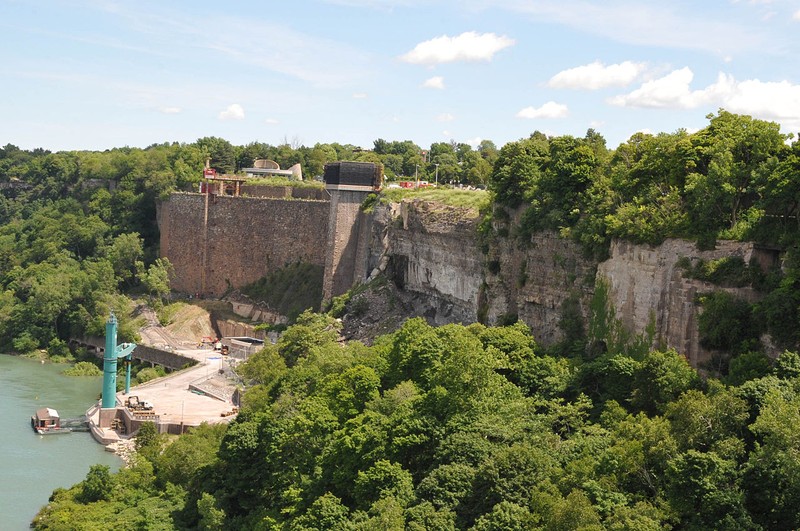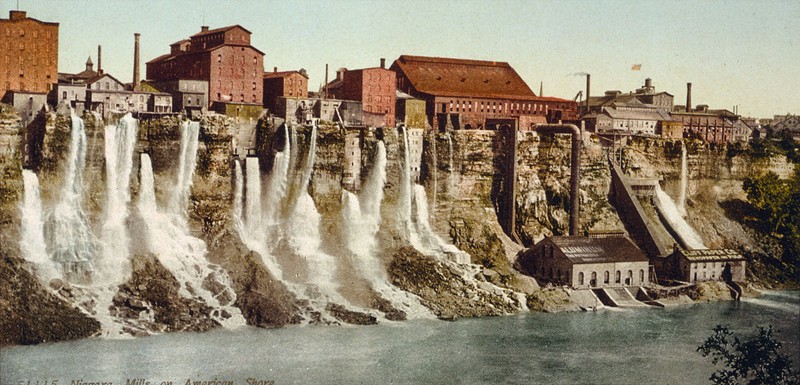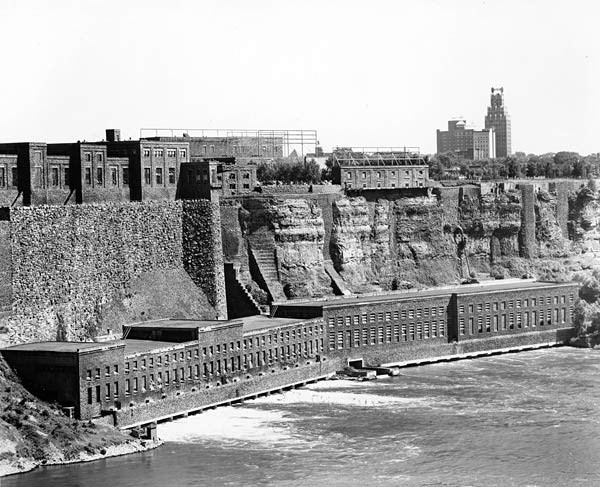Schoellkopf Power Station Site
Introduction
Text-to-speech Audio
The former Schoellkopf Power Station was an impressive facility. Originally built in 1874 and expanded in later years, it produced 450,000 kilowatts of power at its peak. It consisted of two levels. Three powerhouses (3A, 3B, and 3C) were located at the bottom and the upper level featured office buildings and forebays (manmade pools). The existing large stone wall built along the face of the gorge concealed the penstocks (tubes) that supplied water to Powerhouse 3A and includes an elevator shaft running between the two levels. On June 7, 1956, disaster struck. Water seeped from a part of the large wall, causing it crack and give way, sending water and rubble down in a massive earth and rock slide that demolished Powerhouses 3B and 3C. One worker died and the collapse caused a $100 million in damages in today's dollars. The site today is open to the public and is also used by the Maid of the Mist tour boat company.
Images
The Schoellkopf Power Station Site as it appears today.

The site as it appeared in 1900. Stations 1 and 2 are located on the bottom right.

The station reached its final size in 1924 with the completed construction of Station No. 3.

Backstory and Context
Text-to-speech Audio
In 1759, French native Chabert Joncaire built a small loop canal south the falls to power a sawmill. This was the first-known attempt to use the falls for industrial use. In the early 1800s, brothers Augustus and Peter Porter bought this property and surrounding land. They built a gristmill and tannery and expanded the canal. Other companies built mills and factories arrived in the area beginning in the coming years. In 1847, Augustus Porter proposed building a canal that would direct some of the water downriver north of the falls. However, he and Peter died before the idea came to fruition.
In 1853, the Niagara Falls Hydraulic Power & Manufacturing Company was established to build the canal. Construction began that year but the rising cost of the project resulted in the company going bankrupt and the work stopped over a year later. Two subsequent companies—the Niagara Falls Water Power Company and the Niagara Falls Canal Company—continued building the canal, which was completed in 1861. The Civil War prevented it from being used, however, and that continued until 1875 until one company built a gristmill. The first hydraulic plant at the site did not generate electricity but its water turbines powered the drive shafts and belts for the area's mills.
As a result of failing to attract other clients, the Niagara Falls Canal Company went bankrupt and its interests were purchased by Jacob F. Schoellkopf in 1877. The next year, Schoellkopf founded the Niagara Falls Hydraulic Power and Manufacturing Company and enlarged the canal. In 1881, the company built the first hydroelectric power station in Niagara Falls (it became known as Station No. 1). The plant supplied electricity to mills, factories, stores, the city's streetcar system, and the offices of the Niagara Falls Gazette offices. The electricity also lit arc lights that illuminated the Falls.
The company built Station No. 2 in 1896 at the bottom of the gorge to take advantage of the 210-foot drop. It housed four large turbines and was later expanded in 1904. Work on Station No. 3 began in 1905 and would be completed in stages by 1924. The company also built the wall to conceal the penstocks and demolished Station No. 2 in 1925.
Calls for public oversight of hydroelectric power in New York began in the early 1900s. Governor Charles Evans Hughes and other state politicians believed that leasing the water rights to private companies was not in the best interest of the public. However, it was not until after World War I that this came to fruition. Congress passed the Federal Power Act in 1920, which created the Federal Power Commission (FPC). The FPC was authorized to issue 50-year licenses to public or private electricity companies that were located on federal land. In response, states were forced to create their own plans to retain control over navigable waterways. New York Governor (and future U.S. President) Franklin D. Roosevelt signed a bill in 1931 that created the Power Authority of State of New York, which became the first state to authorize a public power authority (it was later renamed the New York Power Authority).
On that fateful day in June, 1956, the large wall started to crack at 10:30 a.m. In Powerhouses 3B and 3C, water began to seep in, the floors cracked, and window panes fell out. Workers diverted water away from the generators using sandbags and ditches they dug. The wall finally started to give way at around 5 p.m. Over the course of the next 30 minutes or so sections of the wall collapsed, pushing much of the two powerhouses into the gorge. Forty workers were in the powerhouses at the time but all but one, Richard Draper, managed to escape. While a number of theories were proposed to explain why the wall collapsed, no definitive cause was ever discovered. Powerhouse 3A, which was severely damaged by fire and did not collapse, was restored and back in operation in January 1957.
The disaster served as the catalyst for the passage of the Lehman Bill, which was proposed in January 1956 by U.S. Senator Herbert Lehman from New York to build a new, much larger hydroelectric power station north of the Niagara Falls in the town of Lewiston. The new station would be controlled by the New York Power Authority as a public utility offering cheap electricity. The project was spearheaded by Robert A. Moses, who was appointed chairman of the Power Authority and believed that licensing power generation to private companies was not in the public's interest. Construction of the new station, which was named the Robert Moses Niagara Hydroelectirc Power Station, began in 1957 and was completed in 1961. Another facility, the Lewiston Pump Generating Plant was built to the east at the same time. Both work in conjunction and are known collectively as the Niagara Power Project. Construction of the station included developing and beautifying the Falls and surrounding area.
The Schoellkopf Station stopped operating in 1961. In the coming years the site was cleared of remaining buildings and converted to how it appears today. It was added to the National Register of Historic Places in 2013.
Sources
Jenkins, Ellen & Thomas, Ph.D. Larissa. "Schoellkopf Power Station Site No. 3." National Park Service - National Register of Historic Places Nomination Form. https://npgallery.nps.gov/GetAsset/48197f0e-7ac3-4d2b-90b0-7231758370de.
"Niagara Power Project." New York Power Authority. Accessed July 15, 2022. https://www.nypa.gov/power/generation/niagara-power-project.
"The Power Plant." Niagara Falls Info. Accessed July 15, 2022. https://www.niagarafallsinfo.com/niagara-falls-history/niagara-falls-tales/accidents-rescues/the-power-plant.
"Schoellkopf Power Plant." Niagara Falls Info. Accessed July 15, 2022. https://www.niagarafallsinfo.com/niagara-falls-history/niagara-falls-power-development/the-history-of-power-development-in-niagara/schoellkopf-power-plant.
All images via Wikimedia Commons: https://en.wikipedia.org/wiki/Schoellkopf_Power_Station
